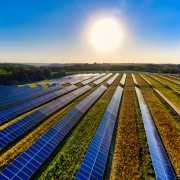AgriSolar News Roundup: Solar Sheep, Five C’s of Agrivoltaics, Illinois Team Developing AgriSolar Game
The Solar Industry’s Mower of Choice: Sheep
“The panels blanket nearly 1,500 acres of a solar farm in Deport, a town near the Oklahoma border. Ely Valdez, the boss, makes sure prairie grasses don’t block sunshine from the panels. His sheep do most of the work. Sheep, the surprise workhorse of renewable energy, are generating several million dollars in annual revenue tidying up solar farms nationwide.
‘It’s changing all of our lives,’ said Mr. Valdez. He expects the flocks he oversees to soon generate several hundred thousand dollars in annual revenue. The number of acres of solar fields employing sheep in the U.S. has grown to tens of thousands from 5,000 in 2018, according to estimates by people in the business. Flock owners charge as much as $500 an acre a year.
The solar industry auditioned several methods for the job, but requirements weeded out expected contenders. Power mowers, which can’t maneuver easily enough under panels to avoid the risk of damaging equipment, are of limited use. “Sheep truly are the appropriate technology for this,” said Michael Baute, vice president of regenerative energy and carbon removal at solar developer Silicon Ranch Corp., based in Nashville, Tenn.” – The Wall Street Journal
The “Five C’s” of Agrivoltaics
“These are among the most important findings of an ongoing agrivoltaics research project called Innovative Solar Practices Integrated with Rural Economies and Ecosystems (InSPIRE). Led by the National Renewable Energy Laboratory (NREL) and funded by the U.S. Department of Energy’s Solar Energy Technologies Office, InSPIRE has just completed its second, three-year phase of research into the synergies between solar energy and agriculture.
In its first phase, InSPIRE tried to quantify the benefits of agrivoltaics and record some early best practices in the emerging field. The project adopts a big-tent approach to agrivoltaics, welcoming any dual use of solar-occupied land that provides ecological or agricultural benefits. That could mean grazing cattle or sheep, growing crops, cultivating pollinator-friendly native plants, or providing ecosystem services and restoring degraded soil.
The InSPIRE project found five central elements that lead to agrivoltaics success, summarized as ‘the five C’s’:
- Climate, Soil, and Environmental Conditions — The ambient conditions of a location must be appropriate for both solar generation and the desired crops or ground cover.
- Configurations, Solar Technologies, and Designs — The choice of solar technology, the site layout, and other infrastructure can affect everything from how much light reaches the solar panels to whether a tractor, if needed, can drive under the panels. “This infrastructure will be in the ground for the next 25 years, so you need to get it right for your planned use. It will determine whether the project succeeds,” said James McCall, an NREL researcher working on InSPIRE.
- Crop Selection and Cultivation Methods, Seed and Vegetation Designs, and Management Approaches— Agrivoltaic projects should select crops or ground covers that will thrive under panels in their local climate and that are profitable in local markets.
- Compatibility and Flexibility — Agrivoltaics should be designed to accommodate the competing needs of solar owners, solar operators, and farmers or landowners to allow for efficient agricultural activities.
- Collaboration and Partnerships — For any project to succeed, communication and understanding between groups is crucial.” – NREL
Illinois University Team Developing Interactive Agrisolar Game
“A team led by University of Illinois, Urbana-Champaign researchers is developing an educational game it hopes can inspire future farmers to think differently about solar power. The app aims to teach kids the emerging concept of agrivoltaics, in which agricultural production is combined with solar photovoltaics. The game will be backed by science from the growing niche of research looking into how solar panel placement affects the growth of various crops.
‘Dual-use land is really a great idea, intuitively, so why not build an app that lets kids explore these really interesting ideas while they’re playing a game?’ said H. Chad Lane, associate chair for educational psychology at the University of Illinois, Urbana-Champaign.
Think Farmville, but instead of gamifying every aspect of running a farm, it will focus on the interaction between crops and solar panels. Researchers are discovering that several plant types can perform better when partially shaded by panels; for others, the reduced production can be offset by extra revenue from selling solar power to the electric grid.” – Energy News Network


